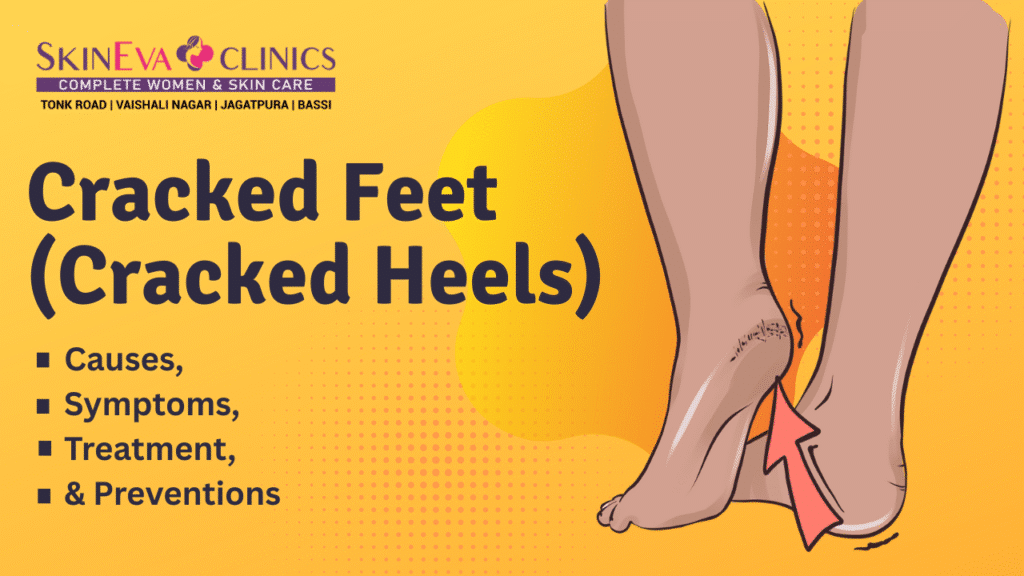Cracked Feet (Cracked Heels): Causes, Symptoms, Treatment, and Prevention

Cracked feet, also known as cracked heels or heel fissures, are a common foot condition that many people experience at some point in their lives. Although many see cracked heels as a minor issue, they can become painful, lead to discomfort, and potentially result in infection, particularly for individuals with diabetes or other health risks.
In this blog, we’ll explore what cracked heels are, their causes, symptoms, treatment options, and how you can prevent them.
What Are Cracked Heels?
When the heel’s skin loses moisture, becomes thicker, and less flexible, it can eventually split due to pressure, causing what we call cracked heels. The condition often begins with callus formation, where a yellow or dark brown patch appears around the heel rim. Over time, small cracks form that may deepen and become painful or bleed.
In severe cases, these deep fissures can result in infections such as cellulitis or diabetic foot ulcers, making early care and treatment essential.
Common Causes of Cracked Heels
Cracked heels can develop due to various environmental, lifestyle, and medical factors. Here’s a breakdown:
1. Dry Skin
- Lack of Moisture: The skin on our feet contains few oil glands, it tends to dry out more quickly than other body parts.
- Weather: Dry climates or cold weather can deplete natural skin hydration, leaving heels rough and more prone to cracking.
- Excessive Hot Water: Long hot showers and harsh soaps remove natural oils.
- Prolonged Standing or Walking: Especially on hard surfaces.
- Walking Barefoot or Poor Footwear: Open-backed shoes like sandals expose heels to dryness and pressure.
2. Medical Conditions
- Diabetes: Leads to poor circulation and dry skin.
- Eczema and Psoriasis: Chronic skin conditions that affect the feet.
- Athlete’s Foot (Fungal Infections): Can cause peeling, dryness, and cracking.
- Hypothyroidism: Affects skin hydration.
- Keratoderma: A genetic disorder causing thickened skin.
3. Other Contributing Factors
- Ageing: Skin becomes thinner and loses elasticity.
- Obesity: Increased pressure on the heels.
- Vitamin Deficiencies: Especially B vitamins.
- Dehydration: Low water intake affects overall skin health.
- Contact Dermatitis: Allergic reactions to footwear materials or chemicals.
Symptoms of Cracked Heels
Cracked heels don’t just affect how your feet look — they can also cause significant discomfort and lead to complications if not addressed promptly. Watch for these warning signs that may indicate developing or worsening heel fissures:
- Visible cracks or splits in the heel skin
- Dry, flaky, or peeling skin
- Pain or discomfort while standing or walking
- Itchiness or burning sensation
- Bleeding or oozing in severe cracks
- Redness, warmth, or swelling (signs of infection)
- For diabetic patients: high risk of ulcers and infections
Treatment for Cracked Heels
🧴 Home Remedies
- Short Showers: Limit to 5–10 minutes with mild, fragrance-free soaps.
- Moisturise Immediately: Apply foot cream with 10–25% urea, salicylic acid, or alpha hydroxy acids within 5 minutes of bathing.
- Overnight Care: Apply petroleum jelly and wear socks to seal in moisture.
- Liquid Bandages: Use during the day to protect deeper cracks and promote healing.
- Foot Soaks & Scrubs: Gentle use of pumice stone to remove thickened skin.
👟 Lifestyle Changes
- Choose Supportive Footwear: Avoid open-back shoes; go for closed, cushioned footwear.
- Stay Hydrated: Drink plenty of water to keep skin moisturized from within.
- Avoid Harsh Soaps and Long Exposure to Water
🧑⚕️ Medical Treatments
- Debridement: Removal of thick skin by a podiatrist.
- Prescription Creams or Ointments
- Wound Care: For severely cracked or infected heels.
- Blood Sugar Control: In diabetics, managing glucose levels is crucial.
🛡️ Prevention Tips for Cracked Heels
- Apply a thick moisturiser (preferably with urea) daily.
- Don’t apply lotions between the toes, as it creates a moist environment ideal for fungal growth.
- Check your heels and soles every day to detect any small cracks before they worsen.
- Use pumice stone or foot files to gently exfoliate.
- Wear well-fitted, cushioned footwear.
- Avoid open-heeled shoes, flip-flops, or walking barefoot.
- Use heel cups to reduce pressure.
- Stay hydrated throughout the day.
- Ensure your diet includes essential nutrients like B vitamins and vitamin E to support skin health.
- Honey Foot Mask: Apply honey after soaking feet as a natural antibacterial moisturiser.
- Use Coconut Oil or Shea Butter: Both act as natural moisturisers that help keep skin soft and nourished.
Final Thoughts
Cracked heels may start as a minor annoyance but can escalate into serious foot problems if not treated in time. With the right foot care routine, hydration, and footwear choices, this common issue can be treated and prevented effectively.



Leave a Comment